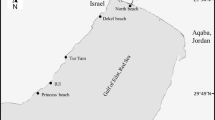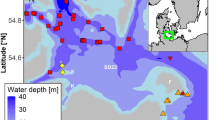Abstract
The periodicity of striae formation in the tropical scallop Comptopallium radula (Indo-West Pacific Ocean) was investigated with an in situ marking technique, using the calcein fluorochrome. To minimize scallop stress caused by excessive handling, in situ benthic chambers were used for marking experiments. Once marked, scallops (shell height range: 38.4–75.8 mm) remained on site in a large benthic enclosure and were collected at regular time intervals to count new striae formed after marking, over a period of 3 months. A 3-h exposure period with calcein (150 mg l−1) was sufficiently long to create a detectable mark in nearly all shells. It was, however, impossible to count the striae in 48.2% of the shells (mainly large specimens) because of a very small growth after marking. Lack of significant mortality during the experiments indicated that tested calcein concentrations were not lethal. A decrease in shell growth rate was observed after marking but the respective impacts of calcein toxicity and changes in environmental conditions could not be discriminated. Our results suggest that in situ calcein marking inside benthic chambers is suitable for shell growth studies of scallops, provided the latter are not too old. After marking, the juvenile C. radula formed an average of one stria every 2.1 days in summer. Reports of 2-day periodicity in biological rhythms are rare. Striae formation in C. radula may be controlled by an endogenous oscillator, synchronized by an environmental cue acting as a zeitgeber, such as seawater temperature or sea level pressure, both of which exhibit 2-day variations in the Pacific Ocean. As in many other scallop species, C. radula forms striae periodically under natural conditions, but this study shows that in pectinid juveniles, this periodicity can deviate from a daily cycle. These results suggest that C. radula shells have tremendous potential for recording environmental conditions during periods ranging from months to a few years and with a resolution of 2 days.








Similar content being viewed by others
References
Antoine L (1978) La croissance journalière chez Pecten maximus (L.) (Pectinidae, Bivalvia). Haliotis 9:117–126
Aschoff J, Daan S, Honma KI (1982) Zeitgeber, entrainment, and masking: some unsettled questions. In: Aschoff J, Daan S, Gross GA (eds) Vertebrate circadian system (structure and physiology). Springer, Berlin Heidelberg New York, pp 13–24
Breau L (2003) Etude de la bioaccumulation des métaux dans quelques espèces marines tropicales: recherche de bioindicateurs de contamination et application à la surveillance de l’environnement côtier dans le lagon sud-ouest de la Nouvelle-Calédonie. Thèse de Doctorat, Université de La Rochelle
Brooks RC, Heidinger RC, Kohler CC (1994) Mass-marking otoliths of larval and juvenile walleyes by immersion in oxytetracycline, calcein, or calcein blue. North Am J Fish Manage 14:143–150
Broom MJ, Mason J (1978) Growth and spawning in the pectinid Chlamys opercularis in relation to temperature and phytoplankton concentration. Mar Biol 47:277–285
Bumguardner BW, King TL (1996) Toxicity of oxytetracycline and calcein to juvenile striped bass. Trans Am Fish Soc 125:143–145
Bustamante P, Grigioni S, Boucher-Rodoni R, Caurant F, Miramand P (2000) Bioaccumulation of 12 trace elements in the tissues of the nautilus Nautilus macromphalus from New Caledonia. Mar Pollut Bull 40:688–696
Chauvaud L (1998) La coquille Saint-Jacques en rade de Brest: un modèle biologique d’étude des réponses de la faune benthique aux fluctuations de l’environnement. Thèse de Doctorat, Université de Bretagne Occidentale
Chauvaud L, Thouzeau G, Paulet Y-M (1998) Effects of environmental factors on the daily growth rate of Pecten maximus juveniles in the Bay of Brest (France). J Exp Mar Biol Ecol 227:83–111
Clark GR (1968) Mollusc shell: daily growth lines. Science 161:800–802
Clark GR (1975) Periodic growth and biological rhythms in experimentally grown bivalves. In: Rosenberg GD, Runcorn SK (eds) Growth rhythms and the history of the Earth’s rotation. Wiley, London pp 103–117
Craig RL, Vincent RA, Fraser GJ, Smith MJ (1980) The quasi 2-day wave in the Southern Hemisphere mesosphere. Nature 287:319–320
Day RW, Williams MC, Hawkes GP (1995) A comparison of fluorochromes for marking abalone shells. Mar Freshw Res 46:599–605
Dijkstra HH (1984) Les pectinidae de Nouvelle-Calédonie: 5—Comptopallium radula. Rossiniana 24:11–12
Epstein S, Buchsbaum R, Lowenstam HA, Urey HC (1953) Revised carbonate-water isotopic temperature scale. Bull Geol Soc Am 64:1315–1326
Fujikura K, Okoshi K, Naganuma T (2003) Strontium as a marker for estimation of microscopic growth rates in a bivalve. Mar Ecol Prog Ser 257:295–301
Gruffydd LD (1981) Observations on the rate of production of external ridges on the shell of Pecten maximus in the laboratory. J Mar Biolog Assoc U K 61:401–411
Hagan ME, Forbes JM, Vial F (1993) Numerical investigation of the propagation of the quasi-two-day wave into the lower thermosphere. J Geophys Res 98:23193–23205
Helm NE, Malouf RE (1983) Rate of production of the external ridges in the bay scallop, Argopecten irradians. Am Zool 23:835
Hurley GV, Tremblay MJ, Couturier C (1987) Age estimation of sea scallop larvae (Placopecten magellanicus) from daily growth lines on shells. J Northwest Atl Fish Sci 7:123–129
Joll LM (1988) Daily growth rings in juvenile saucer scallops, Amusium balloti (Bernardi). J Shellfish Res 7:73–76
Kaehler S, MacQuaid CD (1999) Use of the fluorochrome calcein as an in situ growth marker in the brown mussel Perna perna. Mar Biol 133:455–460
Kennish MJ, Olsson RK (1975) Effects of thermal discharges on the microstructural growth of Mercenaria mercenaria. Environ Geol 1:41–64
Kenyon KE (1996) Bi-daily variation of meteorological properties at sea level across the Pacific along 35°N. Atmos Res 43:31–46
Labrosse P, Fichez R, Farman R, Adams T (2000) New Caledonia. In: Sheppard C (eds) Seas at the millennium: an environmental evaluation. Elsevier, Amsterdam, pp 723–736
Laing I (2000) Effect of temperature and ration on growth and condition of king scallop (Pecten maximus) spat. Aquaculture 183:325–334
Lefort Y (1994) Growth and mortality of the tropical scallops: Annachlamys flabellata (Bernardi), Comptopallium radula (Linne) and Mimachlamys gloriosa (Reeve) in southwest lagoon of New Caledonia. J Shellfish Res 13:539–546
Lefort Y, Clavier J (1994) Reproduction of Annachlamys flabellata, Comptopallium radula and Mimachlamys gloriosa (Mollusca: Pectinidae) in the south-west lagoon of New Caledonia. Aquat Living Resour 7:39–46
Lorrain A (2002) Utilisation de la coquille Saint-Jacques comme traceur environnemental: approches biologique et biogéochimique. Thèse de Doctorat, Université de Bretagne Occidentale
MacFarlane GA, Beamish RJ (1987) Selection of dosages of oxytetracycline for age validation studies. Can J Fish Aquat Sci 44:905–909
Mages M, Woelfl S, Óvári M, v. Tümpling W Jr, Encina F (2004) The use of a portable total reflection X-ray fluorescence spectrometer for trace element determination in freshwater microcrustaceans (Daphnia). Spectrochim Acta B 59:1265–1272
Monaghan JP (1993) Comparison of calcein and tetracycline as chemical markers in summer flounder. Trans Am Fish Soc 122:298–301
Moran AL (2000) Calcein as a marker in experimental studies newly-hatched gastropods. Mar Biol 137:893–898
Owen R, Richardson C, Kennedy H (2002) The influence of shell growth rate on striae deposition in the scallop Pecten maximus. J Mar Biolog Assoc U K 82:621–623
Palmer JD (1975) Biological clocks of the tidal zone. Sci Am 232:70–79
Pannella G, MacClintock C (1968) Biological and environmental rhythms reflected in molluscan shell growth. J Paleontol 42(Mem. 2):64–80
Parsons GJ, Robinson SMC, Roff JC, Dadswell MJ (1993) Daily growth rates as indicated by valve ridges in postlarval giant scallop (Placopecten magellanicus) (Bivalvia: Pectinidae). Can J Fish Aquat Sci 50:456–464
Pirker JG, Schiel DR (1993) Tetracycline as a fluorescent shell-marker in the abalone Haliotis iris. Mar Biol 116:81–86
Price GD, Pearce NJG (1997) Biomonitoring of pollution by Cerastoderma edule from the British Isles: a laser ablation ICP-MS study. Mar Pollut Bull 34:1025–1031
Richardson CA (2001) Molluscs as archives of environmental change. Oceanogr Mar Biol Annu Rev 39:103–164
Richardson CA, Chenery SRN, Cook JM (2001) Assessing the history of trace metal (Cu, Zn, Pb) contamination in the North Sea through laser ablation—ICP-MS of horse mussel Modiolus modiolus shells. Mar Ecol Prog Ser 211:157–167
Rosenberg GD, Jones CB (1975) Approaches to chemical periodicities in molluscs and stromatolites. In: Rosenberg GD, Runcorn SK (eds) Growth rhythms and the history of the Earth’s rotation. Wiley, London, pp 223–242
Rowley RJ, MacKinnon DI (1995) Use of the fluorescent marker calcein in biomineralisation studies of brachiopods and other marine organisms. Bull Inst Oceanogr Monaco Spec Issue 14:111–120
Salby ML (1981) The 2-day wave in the middle atmosphere: observations and theory. J Geophys Res 86:9654–9660
Scherrer B (1984) Biostatistiques. Gaëtan Morin, Québec
Thompson I (1975) Biological clocks and shell growth in bivalves. In: Rosenberg GD, Runcorn SK (eds) Growth rhythms and the history of the Earth’s rotation. Wiley, London, pp 149–161
Wallace JC, Reisnes TG (1985) The significance of various environmental parameters for growth of the iceland scallop, Chlamys islandica (Pectinidae), in hanging culture. Aquaculture 44:229–242
Wilson JH (1987) Environmental parameters controlling growth of Ostrea edulis L. and Pecten maximus L. in suspended culture. Aquaculture 64:119–131
Wilson CA, Beckman DW, Dean JM (1987) Calcein as a fluorescent marker of otoliths of larval and juvenile fish. Trans Am Fish Soc 116:668–670
Wrenn SL (1972) Daily increment formation and synchronization in the shell of the bay scallop. Am Zool 12:32
Acknowledgements
We are especially grateful to Sandrine Chifflet for help during the preparation of calcein solutions, to Christophe Peignon and Alain Lapetite who performed part of SCUBA diving experimentation and subsequent field survey, and to the technical staff of US Chronos for their valuable help in preparing slides. We are also particularly grateful to Jennifer Guarini for her constructive comments and English corrections of the manuscript. This manuscript benefited from critical reviews by David Goodwin and three anonymous referees. This work was supported by IRD, the Programme National Environnement Côtier (PNEC) and ACI-PECTEN. It was part of a 3-year research program funded by IRD and the Région Bretagne. Contribution No. 978 of the IUEM, European Institute for Marine Studies (Brest, France).
Author information
Authors and Affiliations
Corresponding author
Additional information
Communicated by S.A. Poulet, Roscoff
Rights and permissions
About this article
Cite this article
Thébault, J., Chauvaud, L., Clavier, J. et al. Evidence of a 2-day periodicity of striae formation in the tropical scallop Comptopallium radula using calcein marking. Marine Biology 149, 257–267 (2006). https://doi.org/10.1007/s00227-005-0198-8
Received:
Accepted:
Published:
Issue Date:
DOI: https://doi.org/10.1007/s00227-005-0198-8




